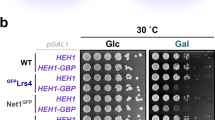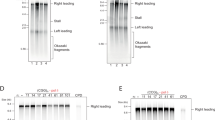Abstract
Repetitive DNA sequences, which constitute half the genome in some organisms, often undergo homologous recombination. This can instigate genomic instability resulting from a gain or loss of DNA1. Assembly of DNA into silent chromatin is generally thought to serve as a mechanism ensuring repeat stability by limiting access to the recombination machinery2. Consistent with this notion is the observation, in the budding yeast Saccharomyces cerevisiae, that stability of the highly repetitive ribosomal DNA (rDNA) sequences requires a Sir2-containing chromatin silencing complex that also inhibits transcription from foreign promoters and transposons inserted within the repeats by a process called rDNA silencing2,3,4,5. Here we describe a protein network that stabilizes rDNA repeats of budding yeast by means of interactions between rDNA-associated silencing proteins and two proteins of the inner nuclear membrane (INM). Deletion of either the INM or silencing proteins reduces perinuclear rDNA positioning, disrupts the nucleolus–nucleoplasm boundary, induces the formation of recombination foci, and destabilizes the repeats. In addition, artificial targeting of rDNA repeats to the INM suppresses the instability observed in cells lacking an rDNA-associated silencing protein that is typically required for peripheral tethering of the repeats. Moreover, in contrast to Sir2 and its associated nucleolar factors, the INM proteins are not required for rDNA silencing, indicating that Sir2-dependent silencing is not sufficient to inhibit recombination within the rDNA locus. These findings demonstrate a role for INM proteins in the perinuclear localization of chromosomes and show that tethering to the nuclear periphery is required for the stability of rDNA repeats. The INM proteins studied here are conserved and have been implicated in chromosome organization in metazoans6,7. Our results therefore reveal an ancient mechanism in which interactions between INM proteins and chromosomal proteins ensure genome stability.
This is a preview of subscription content, access via your institution
Access options
Subscribe to this journal
Receive 51 print issues and online access
$199.00 per year
only $3.90 per issue
Buy this article
- Purchase on Springer Link
- Instant access to full article PDF
Prices may be subject to local taxes which are calculated during checkout




Similar content being viewed by others
References
Szostak, J. W. & Wu, R. Unequal crossing over in the ribosomal DNA of Saccharomyces cerevisiae . Nature 284, 426–430 (1980)
Moazed, D. Common themes in mechanisms of gene silencing. Mol. Cell 8, 489–498 (2001)
Straight, A. F. et al. Net1, a Sir2-associated nucleolar protein required for rDNA silencing and nucleolar integrity. Cell 97, 245–256 (1999)
Bryk, M. et al. Transcriptional silencing of Ty1 elements in the RDN1 locus of yeast. Genes Dev. 11, 255–269 (1997)
Smith, J. S. & Boeke, J. D. An unusual form of transcriptional silencing in yeast ribosomal DNA. Genes Dev. 11, 241–254 (1997)
Capell, B. C. & Collins, F. S. Human laminopathies: nuclei gone genetically awry. Nature Rev. Genet. 7, 940–952 (2006)
Reddy, K. L., Zullo, J. M., Bertolino, E. & Singh, H. Transcriptional repression mediated by repositioning of genes to the nuclear lamina. Nature 452, 243–247 (2008)
Nomura, M. Ribosomal RNA genes, RNA polymerases, nucleolar structures, and synthesis of rRNA in the yeast Saccharomyces cerevisiae . Cold Spring Harb. Symp. Quant. Biol. 66, 555–565 (2001)
Keil, R. L. & Roeder, G. S. Cis-acting, recombination-stimulating activity in a fragment of the ribosomal DNA of S. cerevisiae . Cell 39, 377–386 (1984)
Brewer, B. J. & Fangman, W. L. A replication fork barrier at the 3′ end of yeast ribosomal RNA genes. Cell 55, 637–643 (1988)
Kobayashi, T. & Ganley, A. R. Recombination regulation by transcription-induced cohesin dissociation in rDNA repeats. Science 309, 1581–1584 (2005)
Visintin, R., Hwang, E. S. & Amon, A. Cfi1 prevents premature exit from mitosis by anchoring Cdc14 phosphatase in the nucleolus. Nature 398, 818–823 (1999)
Shou, W. et al. Exit from mitosis is triggered by Tem1-dependent release of the protein phosphatase Cdc14 from nucleolar RENT complex. Cell 97, 233–244 (1999)
Huang, J. & Moazed, D. Association of the RENT complex with nontranscribed and coding regions of rDNA and a regional requirement for the replication fork block protein Fob1 in rDNA silencing. Genes Dev. 17, 2162–2176 (2003)
Rabitsch, K. P. et al. Kinetochore recruitment of two nucleolar proteins is required for homolog segregation in meiosis I. Dev. Cell 4, 535–548 (2003)
Huang, J. et al. Inhibition of homologous recombination by a cohesin-associated clamp complex recruited to the rDNA recombination enhancer. Genes Dev. 20, 2887–2901 (2006)
Gottlieb, S. & Esposito, R. E. A new role for a yeast transcriptional silencer gene, SIR2, in regulation of recombination in ribosomal DNA. Cell 56, 771–776 (1989)
Fritze, C. E., Verschueren, K., Strich, R. & Easton Esposito, R. Direct evidence for SIR2 modulation of chromatin structure in yeast rDNA. EMBO J. 16, 6495–6509 (1997)
Smith, J. S., Caputo, E. & Boeke, J. D. A genetic screen for ribosomal DNA silencing defects identifies multiple DNA replication and chromatin-modulating factors. Mol. Cell. Biol. 19, 3184–3197 (1999)
King, M. C., Lusk, C. P. & Blobel, G. Karyopherin-mediated import of integral inner nuclear membrane proteins. Nature 442, 1003–1007 (2006)
Brachner, A., Reipert, S., Foisner, R. & Gotzmann, J. LEM2 is a novel MAN1-related inner nuclear membrane protein associated with A-type lamins. J. Cell Sci. 118, 5797–5810 (2005)
Rodriguez-Navarro, S., Igual, J. C. & Perez-Ortin, J. E. SRC1: an intron-containing yeast gene involved in sister chromatid segregation. Yeast 19, 43–54 (2002)
Hellemans, J. et al. Loss-of-function mutations in LEMD3 result in osteopoikilosis, Buschke–Ollendorff syndrome and melorheostosis. Nature Genet. 36, 1213–1218 (2004)
Bione, S. et al. Identification of a novel X-linked gene responsible for Emery–Dreifuss muscular dystrophy. Nature Genet. 8, 323–327 (1994)
Kaeberlein, M., McVey, M. & Guarente, L. The SIR2/3/4 complex and SIR2 alone promote longevity in Saccharomyces cerevisiae by two different mechanisms. Genes Dev. 13, 2570–2580 (1999)
Gartenberg, M. R., Neumann, F. R., Laroche, T., Blaszczyk, M. & Gasser, S. M. Sir-mediated repression can occur independently of chromosomal and subnuclear contexts. Cell 119, 955–967 (2004)
Guacci, V., Hogan, E. & Koshland, D. Chromosome condensation and sister chromatid pairing in budding yeast. J. Cell Biol. 125, 517–530 (1994)
Torres-Rosell, J. et al. The Smc5–Smc6 complex and SUMO modification of Rad52 regulates recombinational repair at the ribosomal gene locus. Nature Cell Biol. 9, 923–931 (2007)
Ghaemmaghami, S. et al. Global analysis of protein expression in yeast. Nature 425, 737–741 (2003)
Moazed, D. & Johnson, D. A deubiquitinating enzyme interacts with SIR4 and regulates silencing in S. cerevisiae . Cell 86, 667–677 (1996)
Haas, W. et al. Optimization and use of peptide mass measurement accuracy in shotgun proteomics. Mol. Cell. Proteomics 5, 1326–1337 (2006)
Buker, S. M. et al. Two different Argonaute complexes are required for siRNA generation and heterochromatin assembly in fission yeast. Nature Struct. Mol. Biol. 14, 200–207 (2007)
Beausoleil, S. A., Villen, J., Gerber, S. A., Rush, J. & Gygi, S. P. A probability-based approach for high-throughput protein phosphorylation analysis and site localization. Nature Biotechnol. 24, 1285–1292 (2006)
Kurdistani, S. K. & Grunstein, M. In vivo protein–protein and protein–DNA crosslinking for genomewide binding microarray. Methods 31, 90–95 (2003)
Oakes, M., Siddiqi, I., Vu, L., Aris, J. & Nomura, M. Transcription factor UAF, expansion and contraction of ribosomal DNA (rDNA) repeats, and RNA polymerase switch in transcription of yeast rDNA. Mol. Cell. Biol. 19, 8559–8569 (1999)
Libuda, D. E. & Winston, F. Amplification of histone genes by circular chromosome formation in Saccharomyces cerevisiae . Nature 443, 1003–1007 (2006)
Acknowledgements
We thank C. Yip, T. Walz, J. Huang, M. Bühler, D. Koshland, A. Palazzo, D. E. Libuda, F. Winston, L. Vasiljeva, S. Buratowski, J. E. Warner, C. Anderson, G. A. Beltz, M. Lisby, T. Daniel, L. Ding and the Harvard NeuroDiscovery Optical Imaging Center for technical assistance or materials, and T. Rapoport, T. Iida, M. Motamedi, A. Johnson, M. Onishi, E. Gerace, S. Buker, M. Halic and members of the Moazed laboratory for helpful discussions and comments. This work was supported by the National Institutes of Health and the Howard Hughes Medical Institute (D.M.), and the Canadian Institutes of Health Research Institute of Aging (K.M.). D.M. is a scholar of the Leukemia and Lymphoma Society.
Author Contributions K.M. and D.M. designed experiments and wrote the paper. K.M. and J.S. performed LC–MS/MS analyses. K.M. performed the other experiments. S.P.G. provided mass spectrometry expertise and equipment.
Author information
Authors and Affiliations
Corresponding author
Supplementary information
Supplementary Information
This file contains Supplementary Text, Supplementary Figures 1-8 with Legends, Supplementary Tables 1-6 and Supplementary References (PDF 1734 kb)
Rights and permissions
About this article
Cite this article
Mekhail, K., Seebacher, J., Gygi, S. et al. Role for perinuclear chromosome tethering in maintenance of genome stability. Nature 456, 667–670 (2008). https://doi.org/10.1038/nature07460
Received:
Accepted:
Published:
Issue Date:
DOI: https://doi.org/10.1038/nature07460
This article is cited by
-
The regional sequestration of heterochromatin structural proteins is critical to form and maintain silent chromatin
Epigenetics & Chromatin (2022)
-
Two-step regulation of centromere distribution by condensin II and the nuclear envelope proteins
Nature Plants (2022)
-
Structural insights into nuclear transcription by eukaryotic DNA-dependent RNA polymerases
Nature Reviews Molecular Cell Biology (2022)
-
Nucleolar release of rDNA repeats for repair involves SUMO-mediated untethering by the Cdc48/p97 segregase
Nature Communications (2021)
-
Progerin impairs 3D genome organization and induces fragile telomeres by limiting the dNTP pools
Scientific Reports (2021)
Comments
By submitting a comment you agree to abide by our Terms and Community Guidelines. If you find something abusive or that does not comply with our terms or guidelines please flag it as inappropriate.



